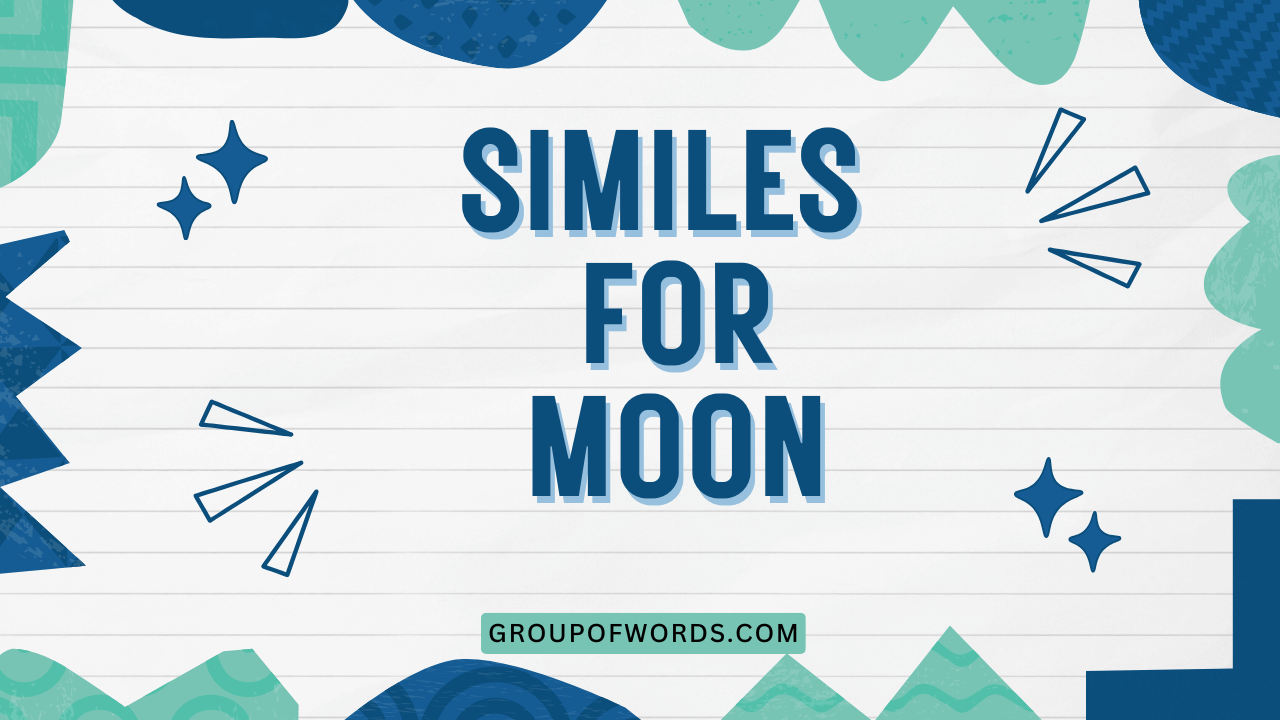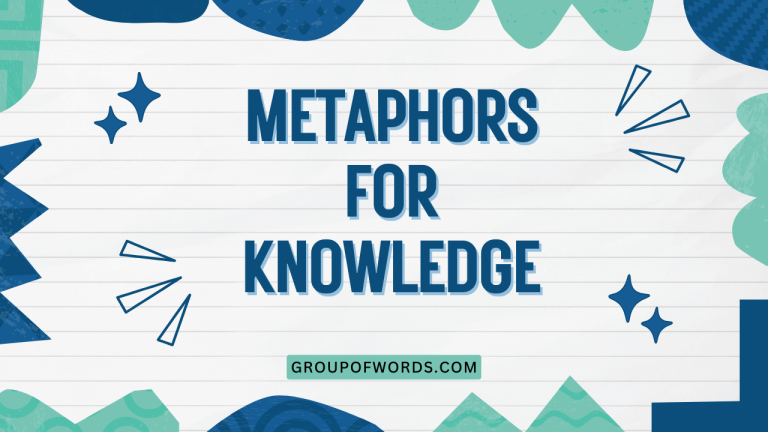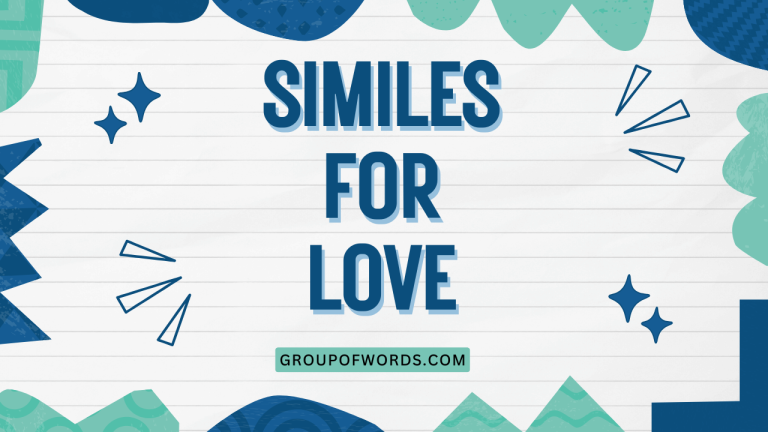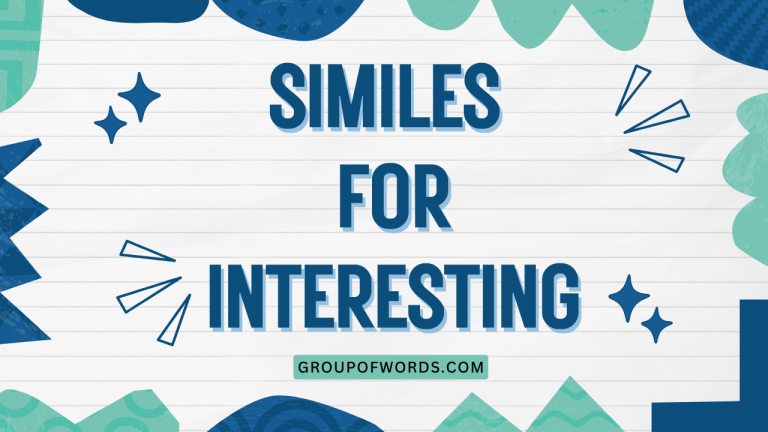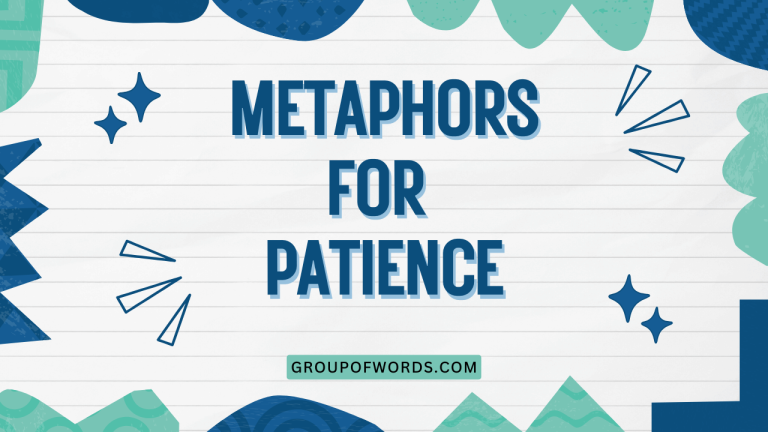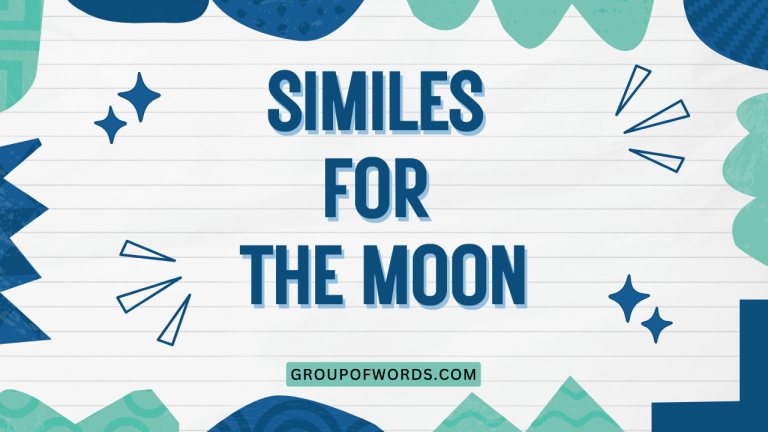Illuminating Language: Mastering Similes for the Moon
The moon, a celestial beacon in the night sky, has captivated humanity for millennia. Its ethereal glow and cyclical phases have inspired countless works of art, literature, and music.
To effectively capture the moon’s multifaceted beauty, writers often turn to similes – figures of speech that use “like” or “as” to draw comparisons between two unlike things. Understanding how to craft compelling similes for the moon not only enhances your descriptive writing but also deepens your appreciation for the nuances of the English language.
This article will guide you through the art of creating evocative moon similes, exploring their structure, types, and usage, complete with examples and practice exercises. Whether you are a student, writer, or simply a language enthusiast, this guide will equip you with the tools to illuminate your prose with the moon’s radiant charm.
This guide is beneficial for students studying figurative language, writers seeking to enhance their descriptive abilities, ESL learners aiming to expand their vocabulary and understanding of English idioms, and anyone interested in exploring the creative potential of similes.
Table of Contents
- Introduction
- Defining Similes and Their Importance
- Structural Breakdown of Moon Similes
- Types of Moon Similes
- Examples of Moon Similes
- Usage Rules for Moon Similes
- Common Mistakes in Moon Similes
- Practice Exercises
- Advanced Topics in Moon Similes
- Frequently Asked Questions
- Conclusion
Defining Similes and Their Importance
A simile is a figure of speech that directly compares two different things using the words “like” or “as.” It’s a powerful tool for creating vivid imagery and conveying complex ideas in a relatable way. Similes help readers understand abstract concepts by linking them to something familiar. In the context of describing the moon, similes allow writers to evoke its various aspects – its shape, color, luminosity, and emotional impact – by drawing parallels to other objects, experiences, or emotions.
Similes are crucial for adding depth and texture to descriptions. Instead of simply stating that the moon is bright, a simile like “The moon was as bright as a silver coin” engages the reader’s imagination and provides a more concrete understanding of the moon’s brilliance.
By choosing specific and evocative comparisons, writers can create a lasting impression on their audience.
The function of a simile is to enhance understanding and appreciation through comparison. Similes bring a sense of novelty and freshness to language, making it more engaging and memorable.
They also allow for subjective interpretation, inviting readers to connect with the text on a personal level.
Structural Breakdown of Moon Similes
A typical simile follows a basic structure: A (the subject) + is like/as + B (the object of comparison). In the case of moon similes, “A” is always the moon, and “B” is the object, concept, or feeling to which the moon is being compared. Let’s break down each component:
- The Subject (A): This is what is being described – in our case, the moon. It can be a specific phase of the moon (e.g., “crescent moon”), a characteristic of the moon (e.g., “moonlight”), or simply “the moon” in general.
- The Connector (is like/as): These words establish the comparison. “Like” and “as” are interchangeable in most simile constructions, but the choice can subtly impact the rhythm and tone of the sentence.
- The Object of Comparison (B): This is what the moon is being compared to. The effectiveness of the simile depends on the aptness and originality of this comparison. It could be a physical object (e.g., “a pearl”), a concept (e.g., “a dream”), or even an emotion (e.g., “hope”).
For instance, in the simile “The moon is like a silver sickle,” “the moon” is the subject, “is like” is the connector, and “a silver sickle” is the object of comparison. This structure provides a clear and concise way to draw a comparison, allowing the reader to visualize the moon’s shape and color more vividly.
Types of Moon Similes
Moon similes can be categorized based on the aspect of the moon they emphasize. Here are some common types:
Similes Based on Shape
These similes focus on the moon’s different phases, from the full moon’s roundness to the crescent moon’s curve. They often use objects with similar shapes to create a visual connection.
Similes Based on Color
These similes highlight the moon’s various hues, from the bright white of a full moon to the pale yellow or orange of a harvest moon. They often use objects of similar colors to emphasize the moon’s visual appearance.
Similes Based on Brightness
These similes emphasize the moon’s luminosity, from its gentle glow to its intense radiance. They often use objects known for their brightness to convey the moon’s brilliance.
Similes Based on Emotional Impact
These similes explore the feelings and associations evoked by the moon, such as peace, mystery, or romance. They often use abstract concepts or emotions to capture the moon’s subjective effect.
Similes Based on Texture
These similes focus on the perceived texture or surface quality of the moon. While less common, they can be effective in creating unique and evocative imagery.
Examples of Moon Similes
Below are several examples of moon similes, categorized by the aspect of the moon they emphasize. Each category contains a variety of similes, ranging from simple to more complex, to illustrate the diverse ways in which the moon can be described.
Similes Based on Shape
This table showcases similes that describe the moon’s shape, using comparisons to familiar objects that share similar forms. These similes help to visualize the moon’s various phases and unique outlines.
| Simile | Explanation |
|---|---|
| The moon was like a silver coin in the sky. | Emphasizes the round and flat shape of the full moon. |
| The crescent moon hung like a curved fingernail clipping. | Highlights the thin, curved shape of the crescent moon. |
| The moon was as round as a dinner plate. | Another comparison emphasizing the fullness and roundness. |
| The waning gibbous moon resembled a slightly deflated balloon. | Captures the shape of the moon as it transitions from full to half. |
| The moon looked like a celestial comma in the inky sky. | A more poetic comparison, highlighting the curved shape. |
| The new moon was as hidden as a secret smile. | Describes the absence of visible shape during the new moon phase. |
| The moon was like a ghostly contact lens in the night. | A modern comparison, emphasizing roundness and transparency. |
| The crescent moon was as sharp as a scythe. | Highlights the sharpness of the crescent shape. |
| The full moon was like a perfectly drawn circle. | Emphasizes the perfection and symmetry of the full moon. |
| The quarter moon looked like a slice of lemon in the dark. | A vivid comparison, highlighting both shape and color. |
| The moon was as incomplete as a half-eaten cookie. | Describes the half-moon phase in a playful way. |
| The gibbous moon was like a pregnant belly in the night sky. | A more evocative comparison with a sense of fullness. |
| The moon resembled a silver sickle ready to harvest dreams. | Highlights the moon’s shape and its association with dreams. |
| It was like a semi-circle made of pearly mist. | Describes the moon’s shape with a soft, ethereal quality. |
| The moon was as bent as an old man’s back. | Emphasizes the curved and aged appearance of the moon. |
| The moon looked like a boomerang returning to the night. | A dynamic comparison, highlighting the curved shape and returning nature. |
| The moon was as arched as a cat stretching in the dark. | A graceful comparison, highlighting the curve and elegance. |
| The moon was like a sliver of ice reflecting the heavens. | Emphasizes the thinness and reflective quality of the moon. |
| The moon resembled a celestial parenthesis in the sky. | A more abstract comparison using a punctuation mark. |
| The moon was as curved as a smile promising secrets. | Highlights the curved shape and its association with mystery. |
| The moon was like a hook dangling in the night sky. | Emphasizes the curved and hanging appearance of the moon. |
| The moon resembled a fragment of a forgotten mirror. | A poetic comparison, highlighting the fragmented and reflective quality. |
Similes Based on Color
The following table presents similes that focus on the moon’s color, comparing it to objects with similar hues. These similes help to paint a vivid picture of the moon’s appearance, from its bright white to its more subtle shades.
| Simile | Explanation |
|---|---|
| The moon was as white as bleached bone. | Emphasizes the stark whiteness of the moon. |
| The harvest moon was like a ripe apricot in the sky. | Highlights the warm, orange hue of the harvest moon. |
| The moon was as pale as skim milk. | Emphasizes the muted, gentle whiteness of the moon. |
| The moon looked like a silver dollar tossed in the air. | Highlights the silvery sheen of the moon. |
| The moon was like a golden coin hanging in the night. | Emphasizes the golden hue, particularly during certain atmospheric conditions. |
| The moon was as gray as an old photograph. | Captures the muted, faded appearance of the moon. |
| The moon resembled a pearl glowing softly in the dark. | Highlights the iridescent and luminous quality of the moon. |
| The moon was like a spotlight shining down on Earth. | Emphasizes the bright, focused light of the moon. |
| The moon was as icy as a glacier gleaming in the sun. | Highlights the cold, white appearance of the moon. |
| The moon looked like a lemon drop suspended in space. | A vivid comparison, emphasizing the yellow hue. |
| The moon was as bronze as an ancient statue. | Captures the warm, metallic tone of the moon. |
| The moon resembled a tarnished silver locket. | Highlights the muted, aged appearance of the moon. |
| The moon was like a creamy cloud reflecting light. | Emphasizes the soft, light-reflecting quality of the moon. |
| It was as golden as honey dripping from the sky. | Describes the moon with a rich, warm color. |
| The moon was as silver as a newly minted coin. | Emphasizes the bright, reflective quality of the moon. |
| The moon looked like a spectral ghost in the heavens. | Highlights the pale, ethereal appearance of the moon. |
| The moon was as ivory as an elephant’s tusk. | A classic comparison, highlighting the smooth, pale color. |
| The moon was like a pewter plate in the night sky. | Emphasizes the muted, metallic gray of the moon. |
| The moon resembled a faded parchment map to the stars. | A more poetic comparison, highlighting the aged appearance. |
| The moon was as white as freshly fallen snow. | Highlights the pure, clean whiteness of the moon. |
| The moon was like a buttery biscuit floating in the dark. | Emphasizes the warm, yellow hue and soft texture. |
| The moon resembled a piece of aged cheese in the sky. | A unique comparison, highlighting the color and texture. |
Similes Based on Brightness
This table contains similes that focus on the moon’s brightness, comparing it to objects known for their luminosity. These similes help to convey the intensity and quality of the moonlight.
| Simile | Explanation |
|---|---|
| The moon was as bright as a lighthouse beacon. | Emphasizes the intense, guiding light of the moon. |
| The moonlight was like liquid silver pouring over the landscape. | Highlights the shimmering, flowing quality of the moonlight. |
| The moon was as radiant as a spotlight on a stage. | Emphasizes the focused, theatrical light of the moon. |
| The moon shone like a diamond in the velvet sky. | Highlights the brilliance and preciousness of the moonlight. |
| The moonlight was as soft as a whisper on the skin. | Emphasizes the gentle, comforting quality of the moonlight. |
| The moon glowed like an ember in the darkness. | Highlights the warm, subtle light of the moon. |
| The moon was as luminous as a firefly in the night. | Emphasizes the small but noticeable light of the moon. |
| The moonlight was like a painter’s brush stroking the world. | A more poetic comparison, highlighting the transformative effect of the moonlight. |
| The moon was as incandescent as a light bulb. | Emphasizes the bright, electric light of the moon. |
| The moonlight was like a gentle hand guiding the way. | Emphasizes the supportive, comforting quality of the moonlight. |
| The moon shone as brightly as a newly lit star. | Highlights the moon’s radiant and celestial presence. |
| The moonlight was like a flood of secrets washing over the land. | Emphasizes the mysterious and pervasive quality of the moonlight. |
| The moon was as dazzling as a mirror reflecting the sun. | Highlights the reflective and intense brightness of the moon. |
| The moonlight was like a silver curtain drawn across the world. | Emphasizes the encompassing and protective quality of the moonlight. |
| It shone like a beacon in the sea of night. | Highlights the moon’s guiding and prominent presence. |
| The moon was as luminous as a thousand candles flickering together. | Emphasizes the collective and warm light of the moon. |
| The moonlight was like a soothing balm for the soul. | Emphasizes the calming and healing quality of the moonlight. |
| The moon shone as brightly as a polished mirror reflecting starlight. | Highlights the reflective and radiant quality of the moon. |
| The moonlight was like a cascade of diamonds falling from the sky. | Emphasizes the brilliant and precious quality of the moonlight. |
| The moon was as radiant as a god watching over the world. | Highlights the powerful and protective presence of the moon. |
| The moonlight was like a gentle lullaby soothing the earth to sleep. | Emphasizes the calming and peaceful quality of the moonlight. |
| The moon shone as brightly as a celestial fire burning in the heavens. | Highlights the intense and eternal quality of the moon. |
Similes Based on Emotional Impact
This table presents similes that focus on the emotional impact of the moon, comparing it to feelings and states of mind. These similes help to convey the subjective and personal experience of observing the moon.
| Simile | Explanation |
|---|---|
| The moon was like a silent promise hanging in the sky. | Emphasizes the sense of hope and anticipation associated with the moon. |
| The moonlight was as comforting as a mother’s embrace. | Highlights the soothing, reassuring quality of the moonlight. |
| The moon was as mysterious as a secret whispered in the dark. | Emphasizes the sense of intrigue and enigma associated with the moon. |
| The moonlight was like a dream unfolding in the night. | Highlights the ethereal, surreal quality of the moonlight. |
| The moon was as lonely as a single star in the vastness of space. | Emphasizes the sense of isolation and solitude associated with the moon. |
| The moonlight was like a memory fading with time. | Highlights the nostalgic, ephemeral quality of the moonlight. |
| The moon was as peaceful as a sleeping child. | Emphasizes the sense of tranquility and serenity associated with the moon. |
| The moonlight was like a gentle reminder of what’s possible. | Emphasizes the hopeful, optimistic quality of the moonlight. |
| The moon was as romantic as a lover’s serenade. | Emphasizes the sense of passion and intimacy associated with the moon. |
| The moonlight was like a soft blanket covering the earth. | Emphasizes the protective, comforting quality of the moonlight. |
| The moon was as elusive as a fleeting thought. | Highlights the transient and intangible quality of the moon. |
| The moonlight was like a whisper of hope in the darkness. | Emphasizes the sense of optimism and resilience associated with the moon. |
| The moon was as serene as a monk meditating in a quiet temple. | Highlights the moon’s calm and contemplative presence. |
| The moonlight was like a balm to soothe a troubled soul. | Emphasizes the moon’s healing and comforting effect. |
| The moon was as constant as a faithful friend. | Highlights the moon’s reliability and steadfast presence. |
| The moonlight was like a gentle hand guiding through the night. | Emphasizes the moon’s protective and supportive role. |
| The moon was as mysterious as an ancient riddle waiting to be solved. | Highlights the moon’s enigmatic and challenging nature. |
| The moonlight was like a bridge connecting dreams to reality. | Emphasizes the moon’s role in inspiring and connecting. |
| The moon was as lonely as a solitary lighthouse in a vast ocean. | Highlights the moon’s isolated yet guiding presence. |
| The moonlight was like a secret language spoken only by the stars. | Emphasizes the moon’s mystical and celestial communication. |
| The moon was as comforting as a warm fire on a cold night. | Highlights the moon’s soothing and welcoming presence. |
| The moonlight was like a silver thread weaving through the tapestry of night. | Emphasizes the moon’s integral and delicate role in the night. |
Usage Rules for Moon Similes
Crafting effective moon similes involves following a few key rules to ensure clarity, impact, and originality:
- Ensure a Clear Connection: The object of comparison should have a clear and logical connection to the moon. The comparison should be easily understood and relatable to the reader.
- Avoid Clichés: While some common similes can be effective, strive for originality. Overused comparisons can sound stale and uninspired.
- Consider Context: The context in which the simile is used should influence the choice of comparison. A simile used in a romantic poem will differ from one used in a scientific description.
- Maintain Consistency: The simile should be consistent with the overall tone and style of the writing. Avoid jarring comparisons that disrupt the flow of the text.
- Use Sensory Details: Incorporate sensory details to make the simile more vivid and engaging. Describe the color, shape, texture, or sound associated with the object of comparison.
For example, instead of saying “The moon was like a light,” which is too general, you could say “The moon was as bright as a streetlamp, casting long shadows on the pavement.” This simile provides more specific details and creates a clearer image in the reader’s mind.
Exceptions to these rules may occur in experimental or highly stylized writing, where unconventional comparisons can be used for artistic effect. However, in most cases, adhering to these guidelines will result in more effective and impactful moon similes.
Common Mistakes in Moon Similes
Even experienced writers can make mistakes when crafting similes. Here are some common errors to avoid:
- Using Vague Comparisons: Similes that are too general or abstract can be ineffective. Incorrect: “The moon was like something in the sky.” Correct: “The moon was like a silver balloon floating in the dark.”
- Creating Illogical Comparisons: The comparison should make sense and be easily understood. Incorrect: “The moon was like a running shoe.” Correct: “The moon was like a silver coin, round and bright.”
- Overusing Clichés: Relying on tired and overused similes can make your writing sound unoriginal. Incorrect: “The moon was as bright as the sun.” Correct: “The moon was as bright as a spotlight, illuminating the field.”
- Mixing Metaphors and Similes: Confusing similes with metaphors can create awkward or nonsensical comparisons. Incorrect: “The moon was a silver coin like in the sky.” Correct: “The moon was like a silver coin in the sky.” (Simile) or “The moon was a silver coin in the sky.” (Metaphor)
- Using Inconsistent Imagery: The simile should align with the overall tone and imagery of the writing. Incorrect: Describing a peaceful night with a simile like “The moon was like a roaring fire.” Correct: “The moon was like a gentle ember, casting a warm glow.”
By being aware of these common mistakes, you can avoid them and craft more effective and compelling moon similes.
Practice Exercises
Test your understanding of moon similes with these practice exercises. Each exercise includes ten questions designed to challenge your ability to create and identify effective similes.
Exercise 1: Completing the Simile
Complete the following similes by filling in the blank with an appropriate comparison.
| Question | Answer |
|---|---|
| 1. The moon was as round as a __________. | 1. ball |
| 2. The crescent moon looked like a __________. | 2. smile |
| 3. The moonlight was as soft as __________. | 3. velvet |
| 4. The moon shone like a __________ in the sky. | 4. pearl |
| 5. The moon was as pale as __________. | 5. a ghost |
| 6. The harvest moon was like a __________. | 6. pumpkin |
| 7. The moon was as bright as a __________. | 7. flashlight |
| 8. The moonlight felt like __________. | 8. a gentle touch |
| 9. The moon was as mysterious as __________. | 9. a secret |
| 10. The moon resembled a __________. | 10. silver shield |
Exercise 2: Identifying Effective Similes
Identify the most effective simile in each pair. Explain your choice.
| Question | Answer |
|---|---|
| 1. a) The moon was like a thing in the sky. b) The moon was like a silver coin in the sky. | 1. b) The moon was like a silver coin in the sky. (More specific and descriptive) |
| 2. a) The moonlight was as soft as something gentle. b) The moonlight was as soft as a mother’s lullaby. | 2. b) The moonlight was as soft as a mother’s lullaby. (More evocative and emotional) |
| 3. a) The moon shone like a bright thing. b) The moon shone like a beacon in the darkness. | 3. b) The moon shone like a beacon in the darkness. (More vivid and imagery-rich) |
| 4. a) The moon was as pale as a pale thing. b) The moon was as pale as a winter ghost. | 4. b) The moon was as pale as a winter ghost. (More descriptive and evocative) |
| 5. a) The moon was like a round object. b) The moon was like a perfectly round pearl. | 5. b) The moon was like a perfectly round pearl. (More specific and visually appealing) |
| 6. a) The moonlight felt like a feeling. b) The moonlight felt like a gentle embrace. | 6. b) The moonlight felt like a gentle embrace. (More sensory and comforting) |
| 7. a) The moon was as mysterious as a mystery. b) The moon was as mysterious as a hidden treasure. | 7. b) The moon was as mysterious as a hidden treasure. (More intriguing and descriptive) |
| 8. a) The moon resembled an object. b) The moon resembled a forgotten dream. | 8. b) The moon resembled a forgotten dream. (More poetic and evocative) |
| 9. a) The moon was as bright as something shiny. b) The moon was as bright as a diamond in the night. | 9. b) The moon was as bright as a diamond in the night. (More vivid and impactful) |
| 10. a) The moonlight was like something soft. b) The moonlight was like silk caressing the skin. | 10. b) The moonlight was like silk caressing the skin. (More sensory and luxurious) |
Exercise 3: Creating Original Similes
Create your own similes for the moon based on the following prompts.
| Prompt | Example Answer |
|---|---|
| 1. Describe the moon’s shape using a simile. | 1. The moon was like a silver sickle hanging in the night. |
| 2. Describe the moon’s color using a simile. | 2. The moon was as white as fresh snow, covering the world in a peaceful blanket. |
| 3. Describe the moon’s brightness using a simile. | 3. The moon shone like a spotlight, illuminating the dark corners of the world. |
| 4. Describe the emotional impact of the moon using a simile. | 4. The moon was like a comforting friend, always there to listen in the quiet of the night. |
| 5. Describe the moon’s texture (real or imagined) using a simile. | 5. The moon looked like a rough, pockmarked stone, weathered by centuries of cosmic storms. |
| 6. Describe the new moon using a simile. | 6. The new moon was as hidden as a secret wish, waiting to be discovered. |
| 7. Describe the full moon using a simile. | 7. The full moon was like a celestial eye, watching over the sleeping world. |
| 8. Describe the crescent moon using a simile. | 8. The crescent moon was like a sliver of hope, promising brighter days to come. |
| 9. Describe the moonlight on water using a simile. | 9. The moonlight on the water was like a path of shimmering diamonds, leading to another world. |
| 10. Describe the moon’s movement across the sky using a simile. | 10. The moon moved across the sky as slowly as a snail, leaving a trail of silver in its wake. |
Advanced Topics in Moon Similes
For advanced learners, exploring more complex aspects of moon similes can further enhance their writing skills. These include:
- Extended Similes: Developing a single simile over multiple sentences or paragraphs can create a more detailed and immersive experience for the reader.
- Juxtaposition: Contrasting two unlike things within a simile can create a sense of tension or irony. For example, “The moon was as cold as ice, yet as inviting as a warm fire.”
- Personification: Giving the moon human qualities within a simile can create a more emotional and relatable connection. For example, “The moon was like a watchful guardian, protecting the earth from harm.”
- Symbolism: Using the moon as a symbol within a simile can add layers of meaning and interpretation to the writing. For example, “The moon was like a mirror reflecting our deepest fears and desires.”
Experimenting with these advanced techniques can elevate your writing and allow you to create truly unique and memorable moon similes.
Frequently Asked Questions
Here are some frequently asked questions about moon similes:
- What is the difference between a simile and a metaphor?
A simile compares two things using “like” or “as,” while a metaphor directly equates two things without using these words. For example, “The moon is like a silver coin” (simile) vs. “The moon is a silver coin” (metaphor).
- Can a simile be too long?
Yes, a simile can be too long if it becomes convoluted or distracting. The comparison should be clear and concise, even in extended similes.
- How can I avoid using clichés in my similes?
To avoid clichés, try to think of original and unexpected comparisons. Consider using sensory details and specific imagery to make your similes more unique.
- Is it okay to use similes in formal writing?
Yes, similes can be used in formal writing, but they should be used sparingly and with careful consideration of the context. Avoid overly casual or informal comparisons.
- How can I make my similes more impactful?
To make your similes more impactful, use strong verbs, vivid adjectives, and sensory details. Choose comparisons that are both surprising and relatable.
- What if I can’t think of any good similes?
If you’re struggling to come up with similes, try brainstorming a list of words and images associated with the moon. Then, try to connect those words and images to other objects, concepts, or emotions.
- Are there any cultural considerations when using moon similes?
Yes, different cultures may have different associations with the moon. Be mindful of these cultural differences when crafting similes, and avoid using comparisons that may be offensive or insensitive.
- How important is it to use similes in poetry?
Similes are a valuable tool in poetry for creating imagery and conveying emotions. While not essential, they can significantly enhance the impact and beauty of a poem.
Conclusion
Mastering the art of crafting moon similes is a valuable skill for any writer or language enthusiast. By understanding the structure, types, and usage rules of similes, you can create vivid and evocative descriptions that capture the moon’s multifaceted beauty.
Remember to strive for originality, avoid clichés, and consider the context in which the simile is used. With practice and attention to detail, you can illuminate your prose with the moon’s radiant charm, adding depth and texture to your writing.
Continue to experiment with different comparisons and techniques, and don’t be afraid to push the boundaries of your creativity. The moon, with its endless allure, offers a wealth of inspiration for crafting compelling similes that will captivate your readers and enhance their appreciation for the
celestial wonders that grace our night sky.
